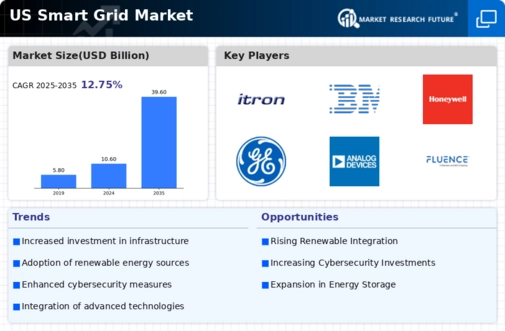Rising Cyber Threats
The increasing frequency and sophistication of cyber threats is a primary driver for the smart grid-security market. As utilities and energy providers face a growing number of cyberattacks, the need for robust security measures becomes paramount. In 2025, it is estimated that cyber incidents targeting critical infrastructure could rise by over 30%. This alarming trend compels organizations to invest in advanced security solutions to protect their assets and data. The smart grid-security market is thus witnessing heightened demand for innovative technologies that can mitigate risks associated with cyber threats. This environment fosters a competitive landscape where companies are incentivized to develop cutting-edge security solutions tailored to the unique challenges of the energy sector.
Increased Public Awareness
Public awareness regarding cybersecurity risks associated with smart grids is on the rise, influencing the smart grid-security market. As consumers become more informed about the potential threats to their energy supply and personal data, they demand greater transparency and security from utility providers. This shift in consumer expectations is prompting energy companies to prioritize investments in security solutions. In 2025, surveys indicate that over 70% of consumers are concerned about the security of their energy infrastructure. This heightened awareness drives utilities to adopt advanced security measures, thereby propelling the growth of the smart grid-security market as they strive to meet consumer demands for enhanced protection.
Growing Adoption of IoT Devices
The proliferation of Internet of Things (IoT) devices within the energy sector is a significant driver for the smart grid-security market. As utilities increasingly integrate IoT technologies to enhance operational efficiency, the attack surface for potential cyber threats expands. In 2025, it is projected that the number of connected devices in the energy sector will exceed 1 billion. This rapid growth necessitates the implementation of comprehensive security measures to safeguard these devices and the data they generate. Consequently, the smart grid-security market is poised for growth as organizations seek to protect their IoT ecosystems from vulnerabilities and ensure the integrity of their operations.
Government Initiatives and Funding
Government initiatives aimed at enhancing the security of critical infrastructure significantly influence the smart grid-security market. In recent years, federal and state governments have allocated substantial funding to bolster cybersecurity measures within the energy sector. For instance, the Department of Energy has announced funding programs exceeding $100 million to support research and development in smart grid technologies. These initiatives not only provide financial resources but also establish frameworks for compliance and best practices. As a result, the smart grid-security market is likely to experience accelerated growth, driven by public sector investments that encourage private sector participation in developing innovative security solutions.
Technological Advancements in Security Solutions
Technological advancements in security solutions are reshaping the smart grid-security market. Innovations such as artificial intelligence, machine learning, and blockchain technology are being integrated into security frameworks to enhance threat detection and response capabilities. In 2025, the market for AI-driven security solutions is expected to grow by over 25%, reflecting the increasing reliance on advanced technologies to combat cyber threats. These advancements not only improve the effectiveness of security measures but also reduce operational costs for energy providers. As a result, the smart grid-security market is likely to expand as organizations adopt these cutting-edge technologies to fortify their defenses against evolving cyber threats.























Leave a Comment